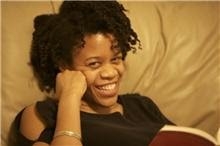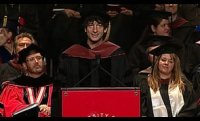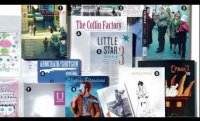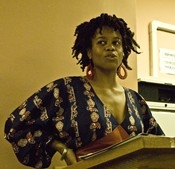Andrei Guruianu and Archetypes in the Unconscious
In May, P&W-supported poet Andrei Guruianu, author of Postmodern Dogma and several other books, taught a workshop sponsored by the Center for Gender, Art and Culture in Binghamton, New York. Participants Lois Westgate and Kit Hartman blog about the experience.
Andrei Guruianu led a group of writers in the process of creating poetry at the Cooperative Gallery 213. The Gallery provides a space for local artists and photographers, and has welcomed writers’ workshops. Andrei has long been an inspiration to fledgling writers in Upstate New York: He taught at Binghamton University and Ithaca College, published a journal of work by writers from his community workshops, founded The Broome Review, and served as Poet Laureate of Broome County.
Our Saturday workshop was a small group, which Andrei prefers “…as it promotes intimate conversations and sharing, and allows people to feel more comfortable once the group settles into the work of writing.” He recommended we try to remove our biases and allow the subject of our poetry to live on its own.
Andrei showed scenes from the movie Iris, in which Judi Dench as British writer Iris Murdock says: “Every human soul has seen, perhaps before their birth, pure forms such as justice, temperance, beauty, and all the great moral qualities which we hold in honour.” We contemplated the archetypes of the unconscious, which are sometimes impossible to convey in words.
The movie includes a montage of Iris and her husband swimming, Iris nude in youth, and in a bathing suit in old age. Andrei asked us to identify concepts this scene evoked and capture these through images in our poetry. For our second poem, he asked us to respond to a scene in which Iris, now suffering from Alzheimer’s, places beach stones on rows of blank paper from her journal, then removes the stones. The papers are swept away.
We read our poems aloud and Andrei pointed out the strongest parts of each. His critiques were honest, but not brutal. An example of one person’s best line inspired by the stones-on-paper scene: “…her fingers remembered the need to create.”
Andrei’s philosophy is this: “I continue to enjoy leading community writing workshops because it helps me stay true to my initial impulse, [which is] to take creative writing out of the classroom. The creative space that opens up when there is no pressure to create or publish is genuine, is as close to the ‘spirit’ of the art as you can get.”
We in Binghamton felt fortunate to have the opportunity to learn from him.
Top photo: Andrei Guruianu. Credit: Kit Hartman. Lower photo: Workshop participants. Credit: Andrei Guruianu.
Support for Readings/Workshops in New York City is provided, in part, by public funds from the New York State Council on the Arts, and the Department of Cultural Affairs, with additional support from the Louis & Anne Abrons Foundation, the Axe-Houghton Foundation, the A.K. Starr Charitable Trust, and Friends of Poets & Writers.








 Most writers acknowledge the benefit of retreat. Getting away enabled me to turn off technology and turn any distractions into sustenance: cooking, watching the lake shift and move, or watching a deer watching me. In this way some retreats are a coming towards: towards nature, towards community, towards solitude, towards discipline. I am grateful to have benefited from different kinds of retreats where I have learned about the craft of poetry, the power of community, and the sacredness of solitude.
Most writers acknowledge the benefit of retreat. Getting away enabled me to turn off technology and turn any distractions into sustenance: cooking, watching the lake shift and move, or watching a deer watching me. In this way some retreats are a coming towards: towards nature, towards community, towards solitude, towards discipline. I am grateful to have benefited from different kinds of retreats where I have learned about the craft of poetry, the power of community, and the sacredness of solitude.

 Nelson asked us to pay particular attention to the construction of the poetic line. Through a sequence of assignments we experienced how careful and intentional construction could lead to a meaningful, surprising, and exciting composition. Formal verse provides the writer with added parameters. Nelson’s poetry exhibits how such constraints used skillfully can produce poems that are wild, challenging, liberating, and free.
Nelson asked us to pay particular attention to the construction of the poetic line. Through a sequence of assignments we experienced how careful and intentional construction could lead to a meaningful, surprising, and exciting composition. Formal verse provides the writer with added parameters. Nelson’s poetry exhibits how such constraints used skillfully can produce poems that are wild, challenging, liberating, and free.